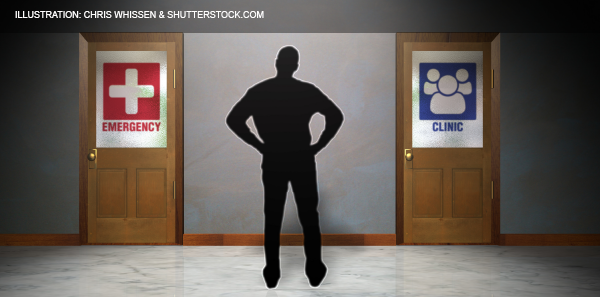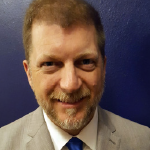
I am a residency-trained, American Board of Emergency Medicine–certified emergency physician and proud of it. I have enjoyed a broad and rich clinical practice. Truthfully, as much as I enjoy a challenging trauma or critical care case, no other part of my clinical practice gives me as much professional satisfaction as the work I do running an opioid addiction treatment clinic.
Explore This Issue
ACEP Now: Vol 36 – No 10 – October 2017How Did I Wind Up Working with Opioid Addicts?
For years, in my emergency department it seemed that the number of patients seeking opioids through the emergency department was growing exponentially, so in 2012, we implemented a very successful opioid-seeking recidivism reduction program, which dramatically cut ED opioid-seeking visits. However, the rapid rise of heroin abuse and opioid overdose in our community continued.
I then realized that the better way to keep an opioid addict from frequenting the emergency department for drug seeking or dying from an overdose would be to enroll that patient into opioid addiction treatment.
I signed up for a buprenorphine class and obtained the “X” license required to be able to prescribe “bupe” for addiction or detox. I started using bupe to treat acute opioid withdrawal in the emergency department and saw how rapidly my patients improved. It was like magic! With no IV medications, just a single sublingual tablet of bupe, the withdrawal symptoms abruptly stopped, and my patients, who just minutes before were vomiting and writhing, suddenly became calm and appropriate. However, even if I prescribed a course of bupe to bridge the patient to an addiction clinic, the patient would sometimes have to wait for two months to see the only reputable physician treating opioid addiction in our community. Thus, I remained frustrated with the inability to make a lasting difference with this challenging patient population.
Great news came in the fall of 2014: A methadone clinic was opening. Unfortunately, the clinic sputtered, and after a few months, the doctor who opened the clinic quit. By the end of 2015, the clinic was on the verge of closing. The clinic was sold, and the new managing company approached me about filling in as the doctor; I laughed. However, as I thought about how desperate I was to have a place to send patients from the emergency department with opioid addiction, I had to consider it.
I was sure that I was going to regret this decision. I was both depressed and nervous. I had never prescribed methadone before, so I needed to learn about this medication, the pharmacokinetics, induction, titration schedules, drug interactions, QT prolongation, peak and trough levels, etc. However, to be candid, I was far less nervous about working with this medication than I was about working with this patient population in a much more intimate, personal setting in contrast to the bright, loud, open emergency department, which helps us maintain the distanced relationship we have with our patients. After all, for me, avoiding intimate, ongoing doctor-patient relationships is one of the draws of emergency medicine.
I never aspired to be any heroin addict’s personal doctor. I just wanted to be able to give a dose of bupe and use the “warm handoff” to pass that patient to another doctor for long-term treatment while I “cleaned up” the emergency department.
After all, from my ED experience, I only knew opioid addicts at their worst: apneic with an overdose; altered; sick and feverish with intravenous drug abuse–associated infections; vomiting and writhing in opioid withdrawal; or manipulative, angry, or agitated trying to get an opioid prescription to treat the pain of withdrawal. I never intended to be handing off those patients to myself.
So How Did I Come to Enjoy This Work So Much?
It didn’t take long for me to see that my clinic was making a profound difference in people’s lives. At the time of induction (when patients receive their first dose of methadone or buprenorphine), many of the patients in my clinic look a lot like our patients in the emergency department in acute opioid withdrawal. In addition to constantly wiping their noses, fidgeting, writhing, and holding a trash can while trying to contain their nausea, they look exhausted, disheveled, and frustrated. Personal hygiene is usually lacking, and they haven’t slept in three or more days.
This is when I obtain the history of their opioid use. Most began being prescribed opioids after an injury or surgery; experimenting with a family member’s medication; or just trying to find something to treat their anxiety, depression, or social phobia. Other patients tell heartbreaking stories of being introduced to heroin as teenagers by a close, older relative. There is often a history of ensuing years of family conflict, job loss, incarceration, prostitution, etc. Other patients are still very high-functioning, with good educations, professional licenses, and enviable jobs. They have come to the clinic because they realize that their addiction has put them on the verge of losing their families and their careers.
All the patients in the clinic want to be free from the yoke of opioid addiction. They only continue to seek and use opioids to keep from experiencing the terrible misery of opioid withdrawal. They are tired of continually feeling sick and having so much of their time and money consumed with securing their next “fix.”
However, often when I see the patients we’ve inducted a few weeks later, they are unrecognizable to me because they look great. They look clean and well-rested, and they are smiling and cheerful. They have begun the road to recovery and have rekindled relationships with their families. Many have returned to work or school or are simply meeting their family obligations, which they failed to do frequently before.
Recently, I asked a patient, Nicole, why she looked so happy. She said, “Because I am kicking ass in life now.” She is 28 years old, and she is now keeping a steady job as a waitress and enjoying it. She is attending classes at a community college, and for the first time in years, she can afford her own apartment. For the first time in 10 years, she feels optimistic about her future.
Certainly, some of our patients drop out of therapy and relapse. Relapse is a part of recovery, and we have inducted some patients more than once. In a year and a half, I have lost three patients to overdoses, two of whom I believe were suicides. I have nearly lost a few others to non-suicidal overdoses, but they were rescued with naloxone. I know that I will lose some of my patients, some at young ages, but far fewer of my patients will die than if they weren’t in treatment.
Our clinic now accepts immediate referrals (often the same day) from physician offices, hospital clinics and inpatient units, the criminal justice system, and, of course, the emergency department. In just 16 months, our clinic patient volume has increased by about 150 new, regular patients. During this time, I have heard many stories like Nicole’s. So many patients are back to work, not in jail, paying taxes, attending school, caring for others, or just living a happier and healthier life.
My patients routinely thank me for working there. At least a dozen patients have said to me, very emotionally and sincerely, “You saved my life.” Truly, the work of the clinic has been life-transforming for so many of our patients.
 Dr. Ketcham is medical director of the opioid addiction treatment service via New Mexico Treatment Services in Farmington, co-medical director of EMS agencies of San Juan County, and a staff emergency physician at San Juan Regional Medical Center in Farmington and Los Alamos Medical Center.
Dr. Ketcham is medical director of the opioid addiction treatment service via New Mexico Treatment Services in Farmington, co-medical director of EMS agencies of San Juan County, and a staff emergency physician at San Juan Regional Medical Center in Farmington and Los Alamos Medical Center.
Pages: 1 2 3 | Multi-Page





2 Responses to “Emergency Physician Runs Methadone Clinic to Treat Opioid Addicts”
October 22, 2017
John E HipskindAwe inspiring!
May 16, 2020
Michele M PowellI wish I could clone you for every City in every State. You’re an angel!